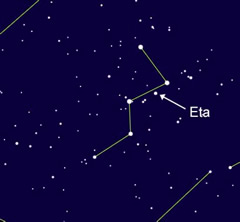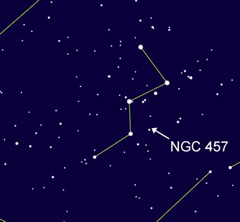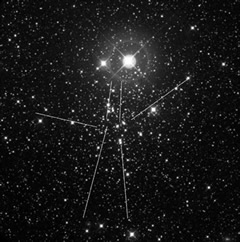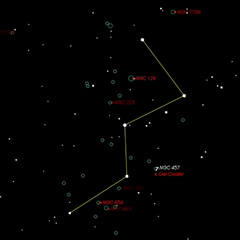
Winter constellations are on the rise, and among everyone's favorite is Cassiopeia, with its distinctive 'W' shape, and famous lore in western mythology. Cassiopeia also happens to be filled with treasures; easily attainable in both binoculars and telescopes.
In mythology, Cassiopeia is the vain queen in the legend of Andromeda and Perseus. She is also the wife of King Cepheus. All these characters are found in the same part of the winter skies. Others that are related, in Greek mythology, are Pegasus and Cetus. We'll eventually visit them all.

Location of the double star Eta Cassiopeiae
My favorite object to observe in Cassiopeia is the double star Eta Cassiopeiae, visible to the naked eye at magnitude 3.43. There are some very fine open clusters throughout the constellation, and some challenging diffuse nebulae, but Eta is special for its amazing color combination: a creamy yellow-white for the larger (primary) star, with the secondary star shining like a copper penny, which is my nickname for it. Eta Cassiopeiae can be split in even the smallest of telescopes.
Eta is our close neighbor at a distance of 19 light years from Earth, and its stars orbit each other once every 480 years. The actual distance between the two stars is 70 AU, (Astronomical Units - the distance between the Earth and Sun.) For comparison, the planet Neptune is 30 AU from the Sun.
The main star is fascinating because it is virtually a twin of our own Sun: it is 97% the Sun's mass, is a G-type main sequence star like the Sun, and 101% the radius of the Sun. So, looking at that creamy yellow-white star gives you a very good idea of what our star would look like from 19 light years away!

NGC 457 - The ET Cluster. It has also been called the Kachina Doll, Owl Cluster, Dragonfly and Skiing Cluster.
I also always enjoy sharing views of the open cluster NGC 457 at public star parties. It is bright and very easy to find by extending an imaginary line from the eastern "leg" of the W about one-third of the length in the opposite direction. This cluster shines at magnitude 6.40, so it is almost visible without optical aid. There are approximately 120 young stars in this group, estimated to be 21 million years old. NGC 457 is relatively distant for such a bright cluster, at 7,900 light years! The cluster has many names given by amateur astronomers. My favorite is the popular "ET Cluster."

The ET Cluster with stick figure.
The bright stars Phi-1 and Phi-2 appear to be the eyes of ET, and dimmer stars of the grouping forming the body and arms of the famous movie character. Visually, in a telescope, you will immediately see the figure.

The many open clusters of Cassiopeia
There are many open clusters in Cassiopeia in addition to ET. I suggest also looking at NGC 654, (M103), and NGC 7789, which can only been seen in a dark sky. M103 is a brilliant triangular grouping, while NGC 7789 is a mysterious maze of dimmer stars all nearly the same magnitude.
Open clusters, young groupings of stars, are common along the band of the Milky Way. Cassiopeia lies directly along our winter Milky Way. Stop by this weekend, and take the tour!
Did you find ET, or did you see a Dragonfly? Were you able to separate Eta Cassiopeiae? Tell us in the comments!
Charts created with Starry Night Pro. NGC 457 image from the Digital Sky Survey.
Mark Wagner is a life-long astronomy enthusiast and deep sky observer. He has spent the past twenty years popularizing amateur astronomy in the San Francisco bay area through his writing and community building. A past president of the San Jose Astronomical Association, he founded what is now the annual Golden State Star Party in California. Please post if you have comments, questions, sketches or images you've taken of the targets mentioned above.






















